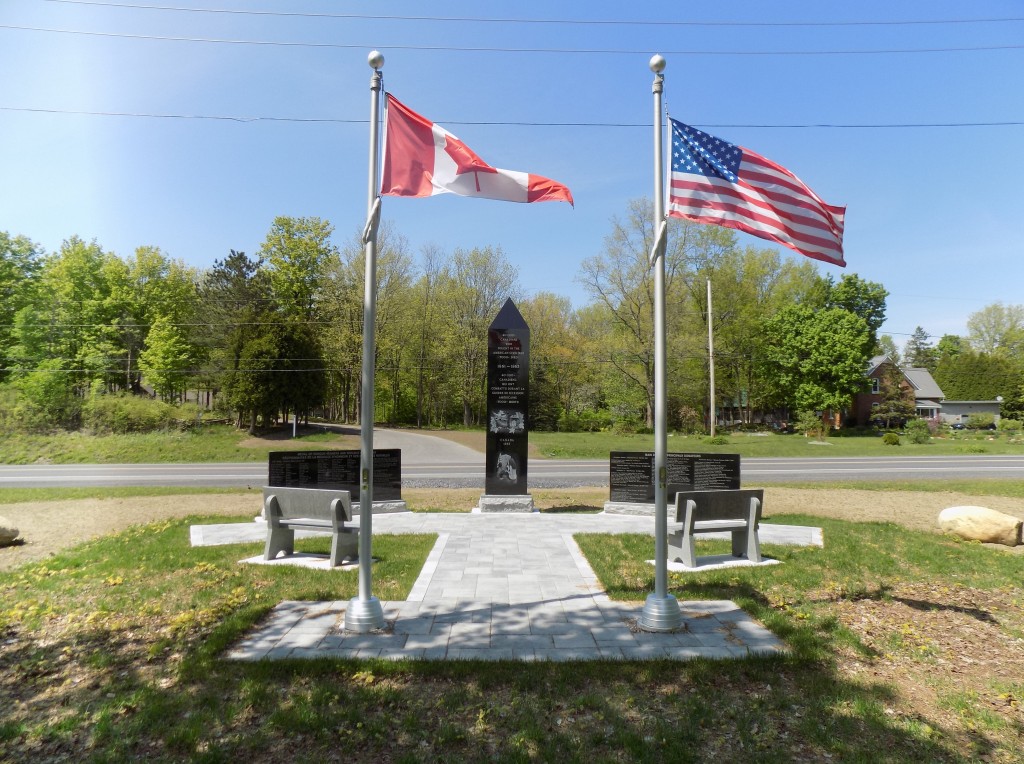Americans have died fighting for Canada–and Canadians have died fighting for the U.S.

The monument to Canadians who fought and died in the American Civil War at Ault Park near Cornwall, Ontario. Photo: James Morgan
The approach of Memorial Day got me thinking about all of the Canadians who have served in various military units in the U.S. over the decades, and of the Americans who served in Canadian units. Both categories of people include many who died in action.
The Union and Confederacy
Canada was still a loose collection of British colonies during the American Civil War, but over 40,000 “Canadians” in total fought in Union and Confederate armies and over 7,000 of those soldiers died in action. In 2017, a monument honoring Canadians who fought and died in the Civil War was built at Ault Park near Cornwall, Ontario.
The “American Legion”
By World War I, Canada was still tied to Britain when it came to its constitution and foreign policy, so when the British declared war on Germany in 1914, Canada was automatically in the war, too. But, the U.S. did not enter the war until 1917. However, there were young Americans who wanted to fight, so they joined what was called the Canadian Expeditionary Force, which was Canada’s army that fought in Europe from 1914 to 1918.
According to the book Canada’s Army by historian Jack Granatstein, Canadian recruiters started actively appealing to Americans to enlist in 1915 when there was a slump in Canadians enlisting. The Canadians wanted to raise up an “American Legion” of U.S. citizens fighting in the C.E.F. They did this despite U.S. laws that declared official neutrality in the early period of the war, and remarks by Canada’s British Governor-General, The Duke of Connaught that “American citizens do not always make the best soldiers.” There was also reluctance to allow African-Americans to enlist in Canada.
Despite those challenges though, an estimated 40,000 U.S. citizens served in the C.E.F., and approximately 2,700 died during their service, according to a 2015 article by historian Chris Dickon. Many of these soldiers were buried in Europe or Canada. Dickon’s article said that Americans could not join the C.E.F. in the U.S., but Canadian recruiting posters were displayed throughout the U.S., especially near the Canadian border.
Fighting facism in Spain
The Spanish Civil War is still an unusual part of Canadian and American military history. After the war began in 1936, Canadians–many with communist or other left-leaning sympathies, began joining the International Brigades which had been formed of volunteers wanting to fight for the Republican side in Spain.
At first, Canadians were joining the Abraham Lincoln and George Washington Battalions of the International Brigades that had been established in the U.S. In 1938, the Canadians formed a separate group, the Mackenzie-Papineau Battalion and continued to fight for the Spanish Republicans until the war ended in 1939. The Battalion was named after William Lyon Mackenzie and Louis-Joseph Papineau, the two leaders of the 1837-38 rebellion against British colonial rule in what is now Ontario and Quebec. Over 1,500 Canadians volunteered to fight in Spain and approximately 400 were killed. There is a monument to the Mackenzie-Papineau Battalion in Ottawa.
WW II
Far fewer Americans fought for Canada in World War II, even though Canada was in the war from its beginning in 1939 and the U.S. did not join until late in 1941. However, Library and Archives Canada in Ottawa has information on 38 U.S. citizens who died fighting in various branches of the Canadian military. And like in World War I, many of those people were from places on or near the Canada-U.S. border, however, none are from New York State.
A good example though is Rifleman Randolph Hartwell Harvin, born in 1924 in South Carolina. His family later moved to Detroit where he ended up working as an usher in a movie theater. He joined the Canadian Army in September, 1943 in London, Ontario, which is a short drive or train ride from Detroit. Harvin was killed in France on August 1, 1944. Flight Sergeant Joseph Roger Emil Nadeau was born in St. Albans, Vermont in 1923, but later lived in Montreal where he joined the Royal Canadian Air Force. He was killed while serving on the crew of a Halifax bomber that crashed in Germany in December, 1943.

Canada did not have a combat role in the Vietnam War, but it was part of the United Nations-led International Control Commission that attempted to keep peace between North and South Vietnam. Canadian Army personnel are seen in this photo looking at maps on the hood of a jeep somewhere in South Vietnam. Photo: Library and Archives Canada, R112-3181-3-E
Vietnam
Canada did not participate in the actual hostilities in the Vietnam War, but an estimated 30,000 Canadians did, and an estimated 147 of them were killed. Seven Canadians were believed to have been taken prisoner and listed as missing in action in Vietnam.
This facet of Canadian and American military history is a contrast with the more common stories of young Americans who did not want to serve in Vietnam and discreetly resettled in Canada to avoid being drafted.
There is a Canadian Vietnam Veterans Memorial in Windsor, Ontario by the Detroit River and the Canada-U.S. border. The monument is known as the North Wall as a sort of detached piece of the large Vietnam Veterans Memorial in Washington, D.C.
Whatever the reasons were for Canadians to have fought for American military units, or for Americans to fight for Canada, many of those people sacrificed their lives while serving.
Tags: canada, history, Memorial Day, United States, war









A small number of Americans also fought both with and against Canadians during the Second Boer War.
http://samilitaryhistory.org/vol156bb.html